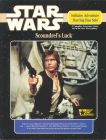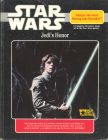 40102. Scoundrel's Luck
40102. Scoundrel's Luck
Author: Troy Denning
Illustrator: Francis Mao
First Published: 1990
ISBN: 0-87431-112-9
Length: 80 pages (157 sections)
Number of Endings: 21 (3 "The End's" and 18 "Try Again's")
Plot Summary: Han Solo's trip to the casino is interrupted when
Princess Leia manages to get herself abducted somehow.
My Thoughts: As I've mentioned many times before, I'm not really
much of a Star Wars fan. As a result, I also can't make any informed
commentary on the book's continuity, faithfulness to characters, or other
issues that fans might catch on to. I can say that the artwork is rather
sketchy (though nicely dynamic in many cases) and that the artist's portrayal
of Han Solo bears little resemblance to Harrison Ford. Despite not being
thrilled by the Star Wars theme, I did actually find the story itself to be
pretty decent. The writing, though not brilliant, is above average
(especially considering that it's third-person, present tense, which I
normally can't stand), and there's more depth of plot and character than
you'll find in your average gamebook; this is at least partially because the
book is obviously aimed at an audience of teen to adult Star Wars fans rather
than at younger children with short attention spans. Of course, the major
trade-off for this depth of story is a shallow game system. Although there
are some sidetracks which make replay worthwhile, and the variables of both
money and energy provide further motivation for trying new things, the book
is ultimately quite linear. The challenge level also doesn't seem quite
right -- although you keep track of resources, it's so hard to run out of
them (especially money, which you can get limitless quantities of by picking
the right option at the first choice) that it barely seems worth mentioning
them at all. I was also somewhat frustrated by the fact that most of the
"good" endings of the book are rather unsatisfying and vague,
though this is balanced by a somewhat clever way of handling the
"bad" ones -- rather than killing characters off, the story stops
at a cliffhanger point and asks speculative questions ("Will Han escape
the rotating blades?") which nicely play to Star Wars' origins in 1930s
adventure serials. Fun stuff, and probably even more fun if you like Star
Wars more than I do.
 40103. Jedi's Honor
40103. Jedi's Honor
Author: Troy Denning
Illustrator: Francis Mao
First Published: 1990
ISBN: 0-87431-111-X
Length: 80 pages (151 sections)
Number of Endings: 22 (2 "The End's" and 20 "Try Again's")
Plot Summary: Luke Skywalker is scouting an asteroid belt for a new
location for the rebel base when he stumbles upon a fellow Jedi's son with a
passion for passive resistance. Trouble follows....
My Thoughts: Like the last book, this is a largely linear but fun
adventure. There's not a whole lot of replay motivation, but victory doesn't
require too much effort. As before, the characters are fairly well-developed
and the art is interesting even if Luke Skywalker doesn't look much like Mark
Hamill. There's a little bit of bookkeeping to do (keeping track of time
passed and the location of Luke's ship), but it's even less intrusive than
the fairly minimal note-taking in the last volume. From what I've
encountered of the Star Wars universe, it seems that the gore and gratuitous
nudity quotient is higher than normal here, though I suppose these things
aren't quite the same in a gamebook as they would be in a movie. Still, I
was at least mildly surprised. More troubling is the book's rather negative
portrayal of passive resistance -- in the Star Wars universe, where
everything is pretty much black and white, I guess passive resistance doesn't
make a whole lot of sense... but some parts of the book still managed to leave
a somewhat bad taste in my mouth. As in the last book, bad endings don't
explicity kill off Luke, making it easier to fit the story into Star Wars
continuity even if you fail, though the failure text isn't formatted as
amusingly as it was before -- it replaces the campy cliffhanger questions
with a less interesting statement that Luke will survive. Ultimately, I'd
say this is about on a par with its predecessor; I found it slightly more
enjoyable, but that's really a matter of personal taste -- both are worth a
look as long as you don't play with the expectation of being able to heavily
influence the plot.
 40601. Imperial Double-Cross
40601. Imperial Double-Cross
Author: Peter Schweighofer
Illustrators: Tim Bobko, Rich Hawran and Mike Vilardi
First Published: 1997
ISBN: 0-87431-502-6
Length: 64 pages (158 sections plus short stories, rules, introductions and an epilogue)
Number of Endings: 7 (5 in "Tibanna Pick-Up" chapter and 2 in "Dead Bantha Gulch")
Plot Summary: You are a 14-year-old living on a boring world where
everyone is preoccupied with commerce. Your first mission is to escape to a
life of adventure, and things just get more complicated from there....
My Thoughts:
This book isn't exactly part of the same series as
the previous two, but since it has a similar format and comes from the same
publisher, it seems worth reviewing on this page. The book is an attempt at
introducing new players to the concept of role-playing. It eases the reader
into the idea with the help of a short story and very brief (optional, in
fact) rules based on West End Games' now-defunct Star Wars RPG. Apart from
the possibly off-putting observation that role-playing is a variant of
"Let's Pretend," the introductory material seems effectively
designed, and I can certainly see someone being intrigued by it without being
scared off by the role-playing concept. Alas, it doesn't seem like the book
actually succeeded in its goals, if its continuing dusty presence on
store shelves and in clearance bins is any indication. It's probably a
matter of marketing -- there's little point in creating a beginner-oriented
introduction to role-playing if you're just going to put it on store shelves
with all the role-playing stuff where only veteran gamers will look at it.
If it had been formatted to better fit in with the Star Wars novels, perhaps
things would have been different. Perhaps not, though; there are many who
say that the days of using solo adventures to promote role-playing are long
past, no matter how good those solo adventures may be. I don't necessarily
agree, but I do admit that solo adventures don't seem as novel as they once
might have....
Anyway, once the introductory material is done with, the rest of the book
alternates between chapters of the solitaire adventure and third-person short
story interludes. The writing is adequate (though not particularly
outstanding), and the story is familiar but with a few mildly interesting
touches (the bounty hunters' den is nicely described, for example). I wasn't
really satisfied by the book, though. I was victorious on my first try, and
the whole adventure went by very quickly, leaving me with the feeling that I
missed quite a lot of details. Unfortunately, since the story is obviously
very linear (the fact that it's split into chapters forces this to be the
case), my motivation to replay things and see what I missed is very low.
Perhaps a beginner would be more willing to revisit the adventure, but it
still seems that the author has wasted time writing a lot of sections that
will never be read -- the balance between freedom of movement and linearity
of story isn't right. Having lots of options isn't all that interesting if
they all have the same ultimate result. I was also frustrated by a bug that
I came across -- at one point, I destroyed an AT-ST Walker and was told to
make a note of this fact. Later on, the same AT-ST Walker was destroyed
again, making my accomplishment meaningless. This doesn't make the gamebook
unwinnable or affect the mechanical side of things in any way, but it's
obviously a major blow against coherency of story. It really should have
been caught in editing. Oh well; this was a noble effort, but one that was
perhaps doomed from the start, and one which should have been polished a bit
more before release. The red-boxed D&D Basic Set still holds the
crown for best introductory solo adventure, and will probably continue to do
so for the foreseeable future.